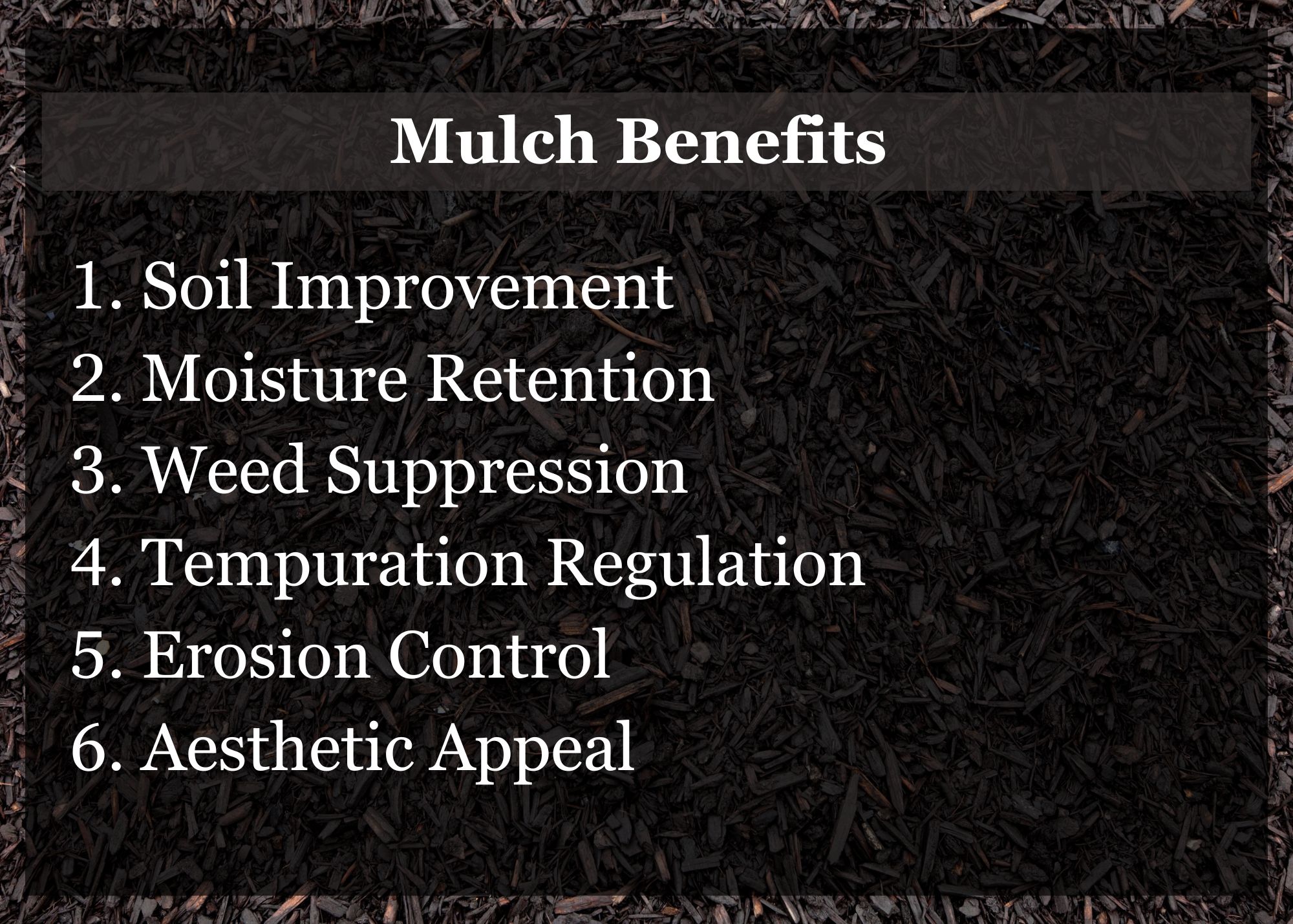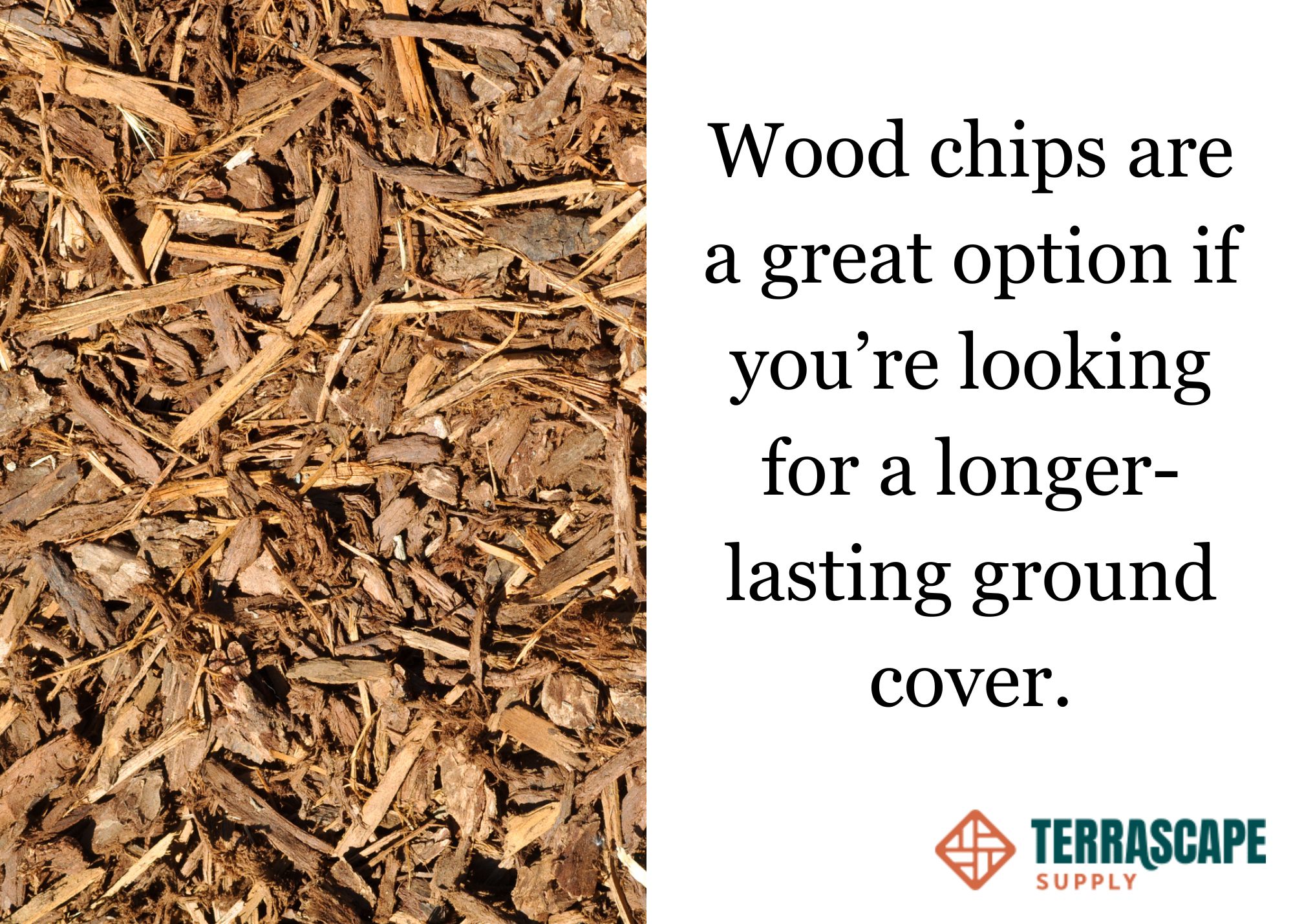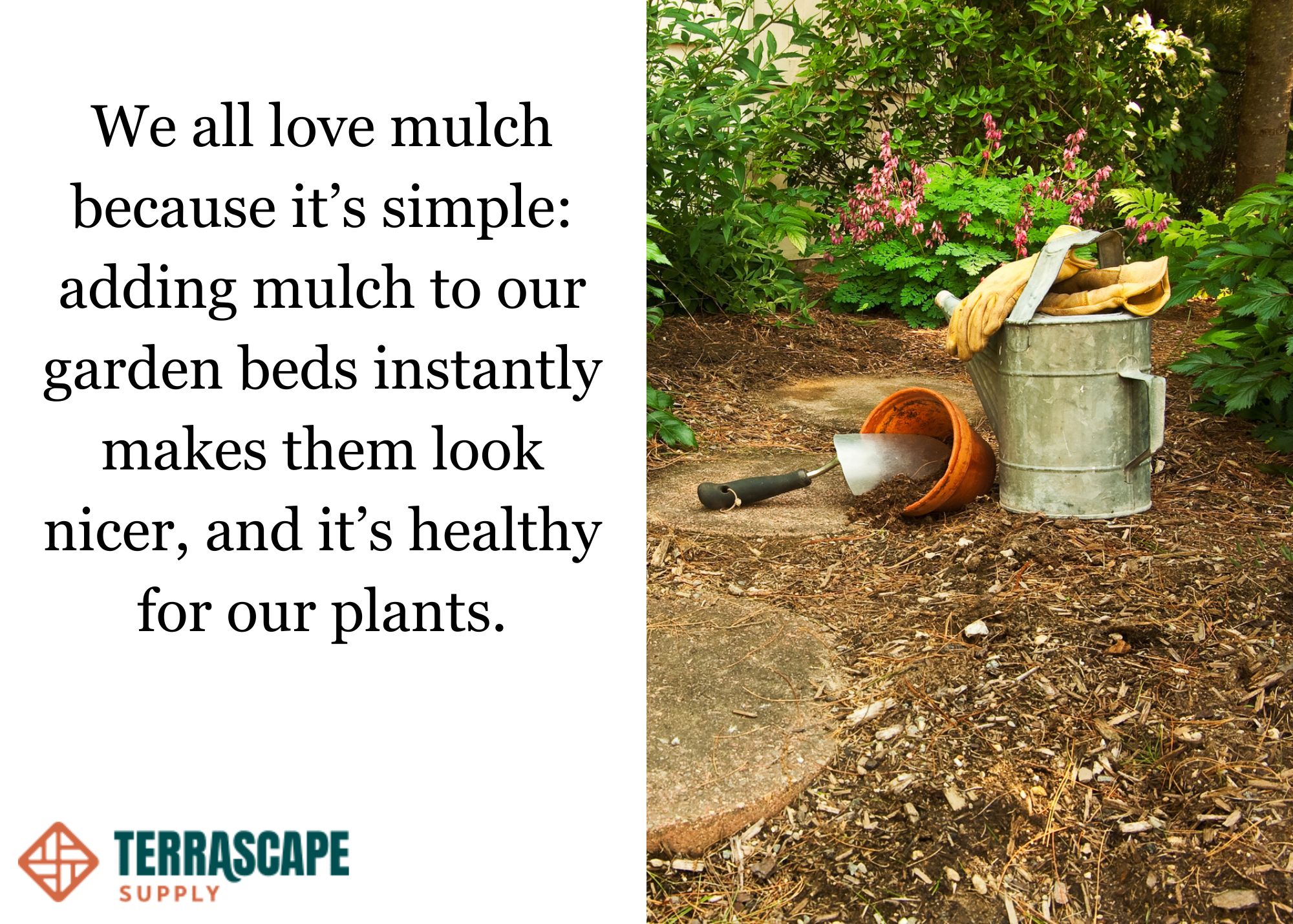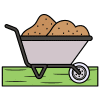A Simple Guide to Mulch: Plus Our Top Seven Mulching Tips!
Do you look enviously at the perfectly manicured lawns as you drive through town, wishing your own unkempt landscaping was a little nicer and more put-together?
Or maybe you’re less concerned about neatness and perfection and more frustrated that nothing seems to grow well in your poor soil.
Luckily, there’s a simple, cost-effective way to solve both problems! Spreading mulch suppresses weeds, builds up the soil, and instantly gives your lawn a tidy, intentional look.
At Terrascape Supply, we want to help you find simple ways to elevate your landscaping. That’s why we provide multiple varieties of mulch to suit your unique preferences and enhance the beauty and health of your garden or outdoor space.
If you’d like to know more about the benefits, types, and uses of mulch, keep reading!
What is Mulch?
Technically, mulch is a general term for anything applied to the soil surface for landscaping purposes. Mulches can be made of:
- Bark
- Wood chips
- Straw
- Manure
- Compost
- Recycled rubber pieces
- Rocks or gravel
- And much more!
Basically, anything you spread on the ground for aesthetics, weed suppression, or moisture retention can be considered mulch.
However, when most people hear the word “mulch,” they imagine something made of bark or wood material. If a friend tells you she’s “spreading mulch,” she’s probably not referring to gravel or manure.
This article sticks to the most basic, shared understanding of mulch. From now on, when you hear us mention “mulch,” we’re talking about simple wood mulch!
What Are the Benefits of Mulch?
Mulch offers many landscaping benefits. Different mulches have different strengths and weaknesses, but let’s review a few of the benefits you can expect from your mulch.
- Soil improvement: Mulch breaks down over time and adds nutrients to the soil.
- Moisture retention: Mulch helps the soil hold onto moisture, which keeps your plants well-hydrated!
- Weed suppression: Mulch suppresses weed growth by blocking sunlight from reaching the soil surface and preventing weed seeds from germinating.
- Temperature regulation: Mulch insulates plant roots from extreme temperature fluctuations, keeping the soil warm in cold weather and cold in warm weather.
- Erosion control: You can use mulch to keep soil in place on sloped areas.
- Aesthetic appeal: Finally, mulch is beneficial because it looks nice! No matter how scruffy your landscaping is, mowing the lawn and putting mulch around your trees and flowerbeds will instantly make your yard look tidy.
Note: If you’re interested in a more comprehensive guide to landscaping, read our blog post on The Ultimate Guide to Landscaping Materials.

What Type of Mulch is Best for You?
All basic wood mulches provide the six basic benefits listed above. However, each mulch type has its strengths and weaknesses. Let’s look at the four most common mulch types so you can decide which type works best for what you need it for.
Bark Mulch
Bark mulch is the best basic mulch if you want something that will break down and add nutrients to your soil. A high-quality bark mulch looks gorgeous, especially if you favor a more natural, rustic look. Bark mulch is often a little cheaper than hardwood mulch, but you’ll have to replace it more often because of how quickly it breaks down.
Hardwood Mulch
Hardwood mulch also adds nutrients to the soil, but it breaks down slowly and won’t add nutrients as quickly. If aesthetics are your main priority, hardwood mulch is probably your best option. Hardwood mulches are usually dyed a deep black, chocolate brown, or russet red. The dye prevents fading, so your landscaping looks neat and tidy for longer.
Ground Cover Mulch
The cheapest mulches are made from a variety of wood debris and are an excellent choice if you’re looking for a simple ground cover to suppress weeds, retain moisture, or control erosion.
Ground cover mulches often fade and break down quickly, giving them less aesthetic appeal.
Most mulch distributors sell a cheap ground cover mulch option. You can also sometimes obtain free ground cover mulch from your city or a local tree trimming company.
If you have a large area of poor soil, ground cover mulch may be an option to help build it up over time, but be careful! Ask lots of questions about how aged the mulch is, what types of wood are used, and whether it contains chemicals from recycled treated lumber because all these factors affect soil quality. Be aware that free mulch may also contain weed seeds or insect larvae!
Wood Chips
Wood chips are a great option if you’re looking for a longer-lasting ground cover. Wood chips contain larger chunks than other mulch options, so you won’t have to replace them as often. They also don’t compact as much as other mulch types, giving them excellent shock absorption and making them ideal for playgrounds and pathways.
If you like the look of wood chips, you can use them in your garden beds, but do your research first! Some plants, like blueberries and apple trees, do well with wood chip mulch. However, wood chip mulch can cause nitrogen depletion and acidification, so they aren’t always a suitable option.

Top Seven Mulching Tips
Are you ready to buy a few bags of mulch and take your landscaping to the next level?
Hold on!
Before you go for it, read our top mulching tips to ensure you have the best mulching experience possible.
Tip #1: Apply mulch at the right time of year
The best time to apply mulch is in the spring. After you plant, make sure your plants are established and growing well, and then apply your mulch. Spread your mulch when the ground is moist but not overly soggy.
If you want your plants to survive the winter, you should mulch again in the fall before the ground freezes.
Tip #2: Buy mulch in bulk
Unless you have a tiny yard with a few small trees or garden beds, you’ll probably be better off buying mulch in bulk instead of constantly running to the store for more bags.
Many landscape supply stores offer bulk mulch at a discounted rate, and some even deliver.
To calculate how much to buy, measure the length and width of your garden beds. With those two numbers, a garden supplier can help you figure out how much you need. Or, you can calculate it yourself by using those two measurements to find the area, multiplying it by your desired depth (typically 2-3 inches,) and converting that number to cubic yards.
Tip #3: Look for inspiration before deciding on a color
Before you run off and buy a large order of mulch, research what mulch colors suit your home the best. Look for ideas on Pinterest, and keep an eye on other people’s landscaping to get an idea of what looks nice to you.
Tip #4: Lay a Weed Suppressant Under Your Mulch
If you truly want to keep grass and weeds from coming up through the mulch, the best solution is to lay some sort of barrier underneath.
Landscape fabric under mulch eliminates weed growth, making your life much easier! Unfortunately, it also prevents the mulch nutrients from building up the soil. If soil regeneration is your ultimate goal, a layer of cardboard under mulch serves the same purpose but is ultimately biodegradable.
Remember: If you lay cardboard under mulch, remove all the tape first since plastic tape won’t break down!
Tip #5: Don’t Pile Mulch Too Thick
One common mulch saying is, “mulch wide, not deep.” Piling on the mulch too thick, especially around tree trunks and plant stems, can harm the plant you’re trying to help. Instead, keep the mulch layer 2-3 inches thick, and try not to pile it up against stems and trunks.
Tip #6: Keep the Cats Away With Herbs
If you’re tired of neighborhood cats pooping in your fresh mulch, one ingenious solution is to grow flowers and herbs that cats dislike! These plants include:
- Lavender
- Rue
- Rosemary
- Lemon Thyme
- Marigolds
Tip #7: Keep Learning!
We all love mulch because it’s simple: adding mulch to our garden beds instantly makes them look nicer, and it’s healthy for our plants.
But to get the best mulching experience, you’ll need to go a step further. Instead of just doing the simplest thing, have a learning mindset. Talk to your neighbors about their mulching and gardening experiences. What worked for them? What didn’t work? Test your soil. What deficiencies does it have? Try adding a thicker layer of mulch one year and a thinner layer the next, and see if it makes any difference one way or another.
And if you kill a few plants, call it a learning experience, and try again next year!

How Terrascape Supply Can Help
At Terrascape Supply, we sell multiple types of mulch for all your landscaping projects.
Whether you’re looking for dyed hardwood mulch, premium bark mulch, or a simple ground cover, we have what you need!
We also sell a variety of other landscaping supplies, including:
- Dirt and soil
- Gravel and rock
- Natural stone
- Pavers and hardscape materials
- Ponds and water features
- Fire pits and fireplaces
- Landscape lighting
And more!
Don’t have a truck? You’re in luck! If you’re ordering mulch, dirt, or stone, we deliver to most of central and south-central Pennsylvania.
For more information, feel free to reach out—we would love to hear from you!



